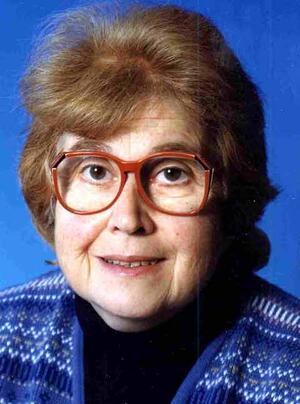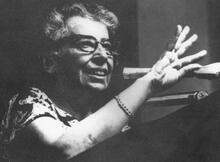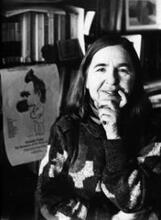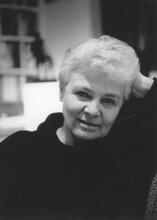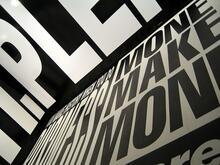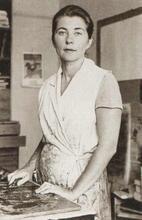Ziva Amishai-Maisels
Art historian Ziva Amishai-Maisels is the author of groundbreaking books, articles, and lectures on modern Jewish and non-Jewish art and on the impact of the Holocaust on art. The importance of her pioneering monumental publication on art and the Holocaust lies in its wide scope and in the originality of its conclusions, which demonstrate the impact of the Holocaust on modern art in general. It established a new area of research and became the basis for all subsequent research on Holocaust art. In recognition of her work, Amishai-Maisels received the Israel Prize in 2004. She is an active scholar who continues publishing significant books and articles on Jewish and non-Jewish modern art and lecturing at conferences held at universities and museums all over the world.
Noted both in Israel and abroad, Ziva Amishai-Maisels is a researcher of modern art, both Jewish and non-Jewish.
Family, Education, and Teaching
Ziva Amishai-Maisels (born Maxine Sylvia Maisels) was born in New York in November 4, 1939. Her father, Moshe (1901–1984), a Hebrew writer and Zionist philosopher, was born in Warsaw and emigrated to the United States in 1931. Moshe was the editor of Hadoar in New York and later editor-in-chief at the Mossad Bialik publishing house in Israel. His works, published under the pen name M. H. Amishai, included Mahshavah ve-Emet (Thought and Truth, 1939). Her mother, Deborah (1901–1962), was born in Warsaw and emigrated with her family to the United States in 1903. Deborah, who studied drawing, bequeathed her love of art to her daughter. Ziva’s sister, Joan (Yael), was born in 1944.
The Maisels family emigrated to Israel in 1959. In 1961 Ziva earned a B.A. in art history at Barnard College in New York City and in 1962 completed her M.A. in the same subject at Columbia University. In 1970 she received her Ph.D. from the Hebrew University of Jerusalem, where she began teaching art history in 1962, first as an assistant instructor and later as senior lecturer. In 1984 she was promoted to the rank of associate professor and in 1995 to that of full professor. In 1975 she was elected chair of the department and in 1995 helped found a master’s degree program for artists, operated jointly by the Hebrew University and the Bezalel Academy of Art and Design, until it was moved entirely to Bezalel in 2008. She retired as professor emerita in 2008.
Scholarship and Service
Amishai-Maisels’ activities in the advancement of art outside the university include serving on the Jerusalem Municipality’s art committee (1974–1975) and on that of the Ministry of Education and Culture (1976–1978). Since 1974 she has been on the editorial board of the Journal of Jewish Art; in 1979 she helped establish the Society for Jewish Art and in 1980 became a member of the board of the Center for Jewish Art. Since the early 1980s she has been a member of the art committee at Yad Vashem, which decides on acquisitions for its museum. From 1990 to 1992 she was a member of the art selection committee of the United States Holocaust Memorial Museum in Washington, D.C.
Over the years Amishai-Maisels has published books and scores of articles in academic journals and exhibition catalogs. These include a book on the works of Marc Chagall in Israel's Lit. "assembly." The 120-member parliament of the State of Israel.Knesset (1973) and two books on Jacob Steinhardt, one dealing with his etchings and lithographs (1981), the other with his late woodcuts (1987). In 1985 she published a book on the religious themes in the works of Paul Gauguin, which is based on her doctoral thesis.
Art and the Holocaust
In 1993, following twenty years of extensive research, Amishai-Maisels published a work on the influence of the Holocaust on art. The first of its kind to attempt to deal with the impact of the Holocaust on artists of various backgrounds, the work is divided into two parts, the first of which treats problems arising from depictions of the Holocaust in works of art. Here Amishai-Maisels deals with two groups of artists: those who were themselves eyewitnesses and those who lived at the time but did not themselves witness the atrocities. She distinguishes between the two, basing herself primarily on the motivation that lay behind the works. Since the eyewitnesses wished above all to document what they had seen, their works are more detailed and realistic in style, while the latter group aimed at creating an artist’s reaction to the events.
The second part of Amishai-Maisels’ book deals with the interpretations of and commentaries on the Holocaust that find expression in the visual depictions. She discerns implicit and explicit symbols common to all the artists, who employed them in order to deal with their difficult theme. Explicit depictions included barbed-wire fences, chimneys, and corpses, while the implicit employed symbols derived from the Bible, such as Job to depict the suffering of the Jewish people, David to depict opposition to the Nazis, and Moloch to represent the Nazis’ evil deeds. Christian symbols were also employed (e.g. the crucifixion of Jesus), as were mythological symbols such as Prometheus and the rape of Europa. Due to the problem of presenting the aggressor and the victim, Amishai-Maisels demonstrates how abstract descriptions serve the artist as a means of psychological suppression or indicate lack of ability or desire to cope with the topic.
In Amishai-Maisels’ opinion, the Holocaust is an archetype that plays an active role in our collective subconscious and will therefore continue to be represented in art. In the course of her discussion, she deals with numerous Israeli artists, dwelling on the special problems that relate precisely to their being Israeli. She concludes by dealing with artists of the “second generation,” children of Holocaust survivors. Amishai-Maisels is convinced that there is clear evidence of the Holocaust in the work of children and even grandchildren of the survivors, who seek to cope with and to understand the events of the Holocaust in their own personal manner, on the one hand, and through their national history, on the other. She explains that she has not dealt with this later art since the different approaches and symbols of the “second generation” warrant separate research.
The importance of Amishai-Maisels’s book lies in its wide scope and in the originality of its conclusions, which demonstrate the impact of the Holocaust on modern art in general. The pioneering nature of her work brought the topic to the attention of academics both in Israel and abroad and established a new area of research. A groundbreaking work, it is today the basis for all research on Holocaust art.
Honors and Awards
Concurrently with writing articles and books, Amishai-Maisels also lectured at conferences held at universities and museums all over the world. Her three major topics were Gauguin, modern Jewish art, and the Holocaust’s impact on art. She also organized academic conferences on Jewish art in Israel and abroad. She has educated an entire generation of researchers of Jewish and general art who are currently employed at museums, universities and colleges throughout Israel.
Recognition of Amishai-Maisels’s work found expression in the award of the Israel Prize in 2004, for “her wide-ranging, profound and inspiring research on modern art in general and modern Jewish art in particular; for her monumental, ground-breaking work on the influence of the Holocaust; and for the combination of her research activities with wide-ranging social and cultural activity that serves as an outstanding model for her students and her colleagues.”
After retiring, Amishai-Maisels has continued writing and publishing significant books. These include a Hebrew sourcebook on the art of the nineteenth century (2010) and a Hebrew course for the Open University on the trends and movements in 20th art (in press as of 2020). Concurrently with publishing articles on modern Jewish art in academic journals, Amishai-Maisels has continued lecturing at conferences held at universities and museums all over the world.
Selected Works
Books
Marc Chagall at the Knesset. New York: Tudor Publishing Co.,1973.
Jakob Steinhardt: Etchings and Lithographs. Tel Aviv: Dvir, 1981.
Gauguin’s Religious Themes. New York: Garland, 1985.
With Eli Bar-On. The Late Woodcuts of Jakob Steinhardt. Nahariya: 1987.
Depiction and Interpretation: The Influence of the Holocaust on the Visual Arts. Oxford: Butterworth-Heinemann, 1993.
The Gateway to Modern Art: Art in the Nineteenth Century: A Sourcebook, Jerusalem: Magnes, 2010 (in Hebrew).
Trends in Modern Art of the 20th Century. Ra'anana: Open University (in press as of 2020).
Articles
“The Jewish Jesus.” Journal of Jewish Art 9 (1982): 84–104.
“Steinhardt and Bialik.” Jewish Book Annual 42 (1984–1985): 137–49.
“The Unknown Bezem.” In Naftali Bezem, Tel Aviv: 1986, ix–l, in Hebrew: 9–47.
“Ben Shahn and the Problem of Jewish Identity.” Jewish Art 12–13 (1986–1987): 304–319.
“The Complexities of Witnessing.” Holocaust and Genocide Studies 2/1 (1987): 123–147.
“Art Confronts the Holocaust.” In After Auschwitz: Responses to the Holocaust in Contemporary Art, edited by Monica Bohm-Duchen, 49-77. London: Lund Humphries, 1995.
"Chagall in the Holy Land: The Real and the Ideal." Jewish Art 23-24: The Real and Ideal Jerusalem in Jewish, Christian and Islamic Art (1997-98), 513-42.
"The Demonization of the "Other" in the Visual Arts." In Demonizing the Other: Antisemitism, Racism and Xenophobia, edited by Robert Wistrich, 44-72. Jerusalem: Harwood Academic Publishers, 1999.
"Jacob Pins: Beneath the Surface." In Jacob Pins: Drawings and Oil Paintings, 1942-2000, edited by Jacob Pins, Ronit Sorek, and Annie Lopez, 4-21. Jerusalem: J. Pins, 2000.
"Origins of the Jewish Jesus." In Complex Identities: Jewish Consciousness and Modern Art, edited by Matthew Baigell and Milly Heyd, 51-86. New Brunswick: Rutgers University Press, 2001.
“Haunting the Empty Place.” In Absence/Presence: Critical Essays on the Artistic Memory of the Holocaust, edited by Stephen C. Feinstein, 123-150. Syracuse, NY: Syracuse University Press, 2005.
“Menasseh Ben Israel and the Wandering Jew.” Ars Judaica 2 (2006): 59-82.
“The Disappearance of the Identity of a Holocaust Victim in Art." In Jewish Artists and Central-Eastern Europe: Art Centers – Identity – Heritage from the 19th Century to the Second World War, edited by Jerzy Malinowski, Renata Piątkowska and Tamara Sztyma-Knasiecka, 407-417. Warsaw: Wydawnictwo "DiG", 2010.
"L'Image Biblique chez Chagall: Conflit et Réconciliation." In Chagall et la Bible, edited by Laurence Sigal-Klagsbald, 58-85. Paris: Musée d'art et d'histoire du judaïsme, 2011.
“The Zionist Dream: Harsh Realities and Recurrent Hope.” In Mountain-Field-Home Installations 1995-2013: Avner Bar Hama, Multidisciplinary Artist, A Personal Journey into Jewish-Israeli Discourse, edited by Hava Pinchas-Cohen, 46-60 (English); 41-61 (Hebrew). Jerusalem: Rubin Mass, 2013.
"De Pinchas Burstein à Maryan." In Maryan 1927-1977: La Ménagerie humaine, edited by Nathalie Hazan-Brunet, 67-75. Paris: Musée d'art et d'histoire du judaïsme, 2013.
"Ayana Friedman: Layers of Feminist Struggle." Journal of Modern Jewish Studies 15 (March 2016): 131-157.
“Chagall's Jewish Identity.” In Art in Jewish Society, edited by Jerzy Malinowski, Renata Piątkowska, Malgorzata Stolarska-Fronia, Tamara Sztyma, 171-178. Warsaw–Toruń: Polish Institute of World Art Studies, 2016.
“Barasch: The Artist,” In Vom jüdischen Bilderverbot zur Gründung israelischer Kunstgeschichte: Zu Leben und Werk des Kunsthistorikers Moshe Barasch, edited by Christine Holste and Richard Faber, 65-96. Würzburg: Königshausen et Neumann, 2019.

